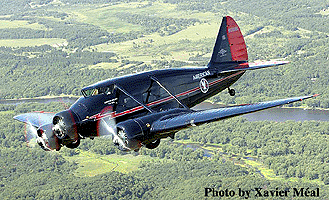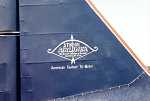
1936 Stinson Model A Trimotor
Photo taken in October of 2004 - Day of it's first flight upon coming out of restoration.
A non-flying
replica in
Discover Aviation Days, 1999



Oshkosh, WI, - 1997

Alaska, 1968
Restoration
Photos from April 2002
The Stinson Aircraft Company’s last
trimotor was a low-wing monoplane, designed in 1933 as an eight-seat
feeder-liner for American Airlines. Featuring an unusual double-tapered wing
that, combined with its tubby fuselage and forward-raked windscreen, gave it a
markedly sinister appearance, it also boasted retractable undercarriage that
left the lower part of the wheels exposed below the engine nacelles while in the
raised position, as many pilots forgot to lower the undercarriage on landing.
Passengers were seated in two rows of three and a paired seat behind the
enclosed cockpit, while fitted aft were a hold for 500 pounds of luggage and
freight, and that ultimate luxury for the time, an on-board lavatory.
A total of 30 Stinson Model As
were built until production ceased in 1936. It was one of many promising designs
whose commercial success was cut short by the introduction of the stressed-skin
Boeing 247 and Douglas DC-2 Because the waiting lists for either the new Boeing
or Douglas aircraft were already too long Airlines of Australia (AOA) ordered
three Stinson Model As in January 1936. These aircraft were VH-UGG
Lismore (arrived per s.s.
City of Winchester on 27
March), VH-UHH Brisbane
(arrived per s.s. Wichita
on 22 June) and VH-UKK Townsville
(arrived 22 July in the s.s. City of Manilla).
All three were quickly reassembled and entered the Sydney - Brisbane service,
proving so successful that in August AOA ordered a fourth example VH-UYY
Grafton – the very last Stinson
Model A to be built – which arrived at Sydney on board s.s.
Port Alma on 14 December.
With posturing from both AOA
and Australian National Airways (ANA) to cut into each other’s turf by late
1936, early efforts by ANA to gain a controlling interest in AOA failed, until
the tragic losses of VH-UHH Brisbane in the McPherson Ranges on 19 February 1937
and VH-UGG Lismore on 28
March halved AOA’s main-line fleet. A merger took effect in March 1937, although
the two companies retained separate identities until AOA was formally absorbed
into ANA on 1 July 1942. The two surviving Stinsons were then renamed VH-UKK
Binana and VH-UYY
Tokana, in conformity with ANA
nomenclature.
During the Second World War spare
parts for the Stinsons' aging Lycoming radial engines were impossible to obtain,
and it was decided to rebuild both aircraft with twin Pratt & Whitney Wasps. The
additional power allowed both aircraft to fly faster and carry higher loads,
although fuel dumps had to be fitted to allow them to remain under their maximum
landing weight of 10,750 lb (4,876 kg), in case of an aborted take-off.
On completion at Essendon,
Victoria in May 1943, Binana
returned to the Brisbane-Cairns, Queensland run, while
Tokana was similarly converted
and re-entered service in October on the run between Melbourne (Essendon),
Kerang, Victoria, Mildura, Victoria and Broken Hill, New South Wales.
Binana was later transferred to
the Melbourne-Tasmania service.
On the morning of 31 January
1945 Tokana was on the
Essendon to Kerang leg of its regular service when the port wing separated in
flight between Redesdale and Heathcote, fifty miles north of Melbourne. The
aircraft then plunged to the ground, killing both crew and the full load of
eight passengers. An investigation revealed that metal fatigue had developed in
the wing’s lower main spar boom attachment socket, the actual failure possibly
being instigated by the aircraft encountering a particularly heavy gust of wind.
It was the first known occurrence of this type of accident in an aircraft
anywhere in the world, but it was to become a problem all too common in later
years where progressively larger aircraft would be built from light-weight
alloys that were more susceptible to the underlying metallurgical phenomenon. It
being assumed that the same problems could occur in
Binana, its certificate of airworthiness was
cancelled, and the old aircraft was subsequently broken up.
Outside of Australia, examples
of the Stinson Model A soldiered on in such far-flung corners of the globe as
Korea and Alaska for some years. One example, still survives, having crashed in
Alaska in 1947, being recovered and rebuilt in 1979 it passed to the Aviation
Heritage Museum at Anchorage, Alaska in 1988 and then to Greg Herrick's Golden
Wings Flying Museum in Minneapolis, Minnesota. A non-flying scale replica was
built for a television movie account of the 1937 McPherson Ranges disaster,
The Riddle of the Stinson.
Operators:
American Airlines
Central Airlines
Airlines of Australia
Australian National Airways
Specifications:
Crew: Two (pilot and co-pilot)
Capacity: 8 passengers
Length: 36 ft 10 in (11.22 m)
Wingspan: 60 ft (18.29 m)
Height: 11 ft 6 in (3.51 m)
Empty weight: 7,200 lb (3,370 kg)
Loaded weight: 10,500 lb (4,760 kg)
Max takeoff weight: 11,200 lb (from 1944, as
twin engine) (5,080 kg)
Powerplant: 3 × Lycoming R-680-5
nine-cylinder Radial, 260 hp (194 kW) each
Maximum speed: 128 mph (206 km/h)
Cruise speed: 116 mph (187 km/h)
Range:
490 miles (790 km)
Click HERE for a detailed info PDF file on this aircraft
For more restoration photo's, please go to HO Aircraft Website